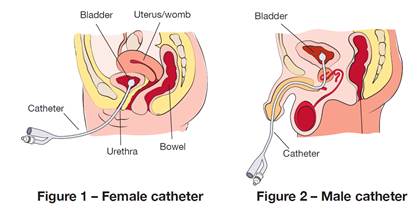Your indwelling urinary catheter
How your catheter works
Your catheter is a hollow tube that is inserted into your bladder to drain urine.
It is inserted into the bladder through the urethra (the channel you normally urinate through) and is known as urethral catheterisation.
Your catheter will not fall out because it is held in place by a small balloon. It is inflated with sterile water after the catheter is inserted into the bladder (see figures 1 and 2).

Never try to remove your catheter without medical or nursing advice. You may cause an injury to yourself.
Most catheters can be left in place for up to 12 weeks, but this may vary under different circumstances.
The first catheter change will be done about 6 weeks after the first insertion.
A decision will be made by the nurse when the next change will be.
This will be reassessed if you have any problems.
Your catheter can be changed by your doctor or nurse:
- at home
- at your hostel or nursing home
- in the hospital outpatient department.
Your doctor or nurse will advise you of the arrangements for changing your catheter.
The catheter should be comfortable to wear and should not pull.
Positioning your catheter correctly will help make it comfortable.
Sexual activity
Sexual activity may continue with an indwelling urinary catheter in place.
You may prefer to discuss with your doctor the use of a suprapubic catheter.
It is important to wash around the catheter prior to sexual intercourse.
Men should fold the catheter along the side of the erect penis and hold in place with a condom.
Women should tape the catheter up onto the stomach.
Only water based lubricants should be used to assist with sexual intercourse. Other lubricants may damage the catheter.
Where to get help
Remember
- Your catheter is a hollow tube that is inserted into your bladder to drain urine.
- Your catheter will not fall out because it is held in place by a small balloon.
- Never try to remove your catheter without medical or nursing advice.
Acknowledgements
Royal Perth Hospital
This publication is provided for education and information purposes only. It is not a substitute for professional medical care. Information about a therapy, service, product or treatment does not imply endorsement and is not intended to replace advice from your healthcare professional. Readers should note that over time currency and completeness of the information may change. All users should seek advice from a qualified healthcare professional for a diagnosis and answers to their medical questions.